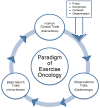Cancer, physical activity, and exercise
- PMID: 23720265
- PMCID: PMC4122430
- DOI: 10.1002/cphy.c120005
Cancer, physical activity, and exercise
Abstract
This review examines the relationship between physical activity and cancer along the cancer continuum, and serves as a synthesis of systematic and meta-analytic reviews conducted to date. There exists a large body of epidemiologic evidence that conclude those who participate in higher levels of physical activity have a reduced likelihood of developing a variety of cancers compared to those who engage in lower levels of physical activity. Despite this observational evidence, the causal pathway underlying the association between participation in physical activity and cancer risk reduction remains unclear. Physical activity is also a useful adjunct to improve the deleterious sequelae experienced during cancer treatment. These deleterious sequelae may include fatigue, muscular weakness, deteriorated functional capacity, and many others. The benefits of physical activity during cancer treatment are similar to those experienced after treatment. Despite the growing volume of literature examining physical activity and cancer across the cancer continuum, a number of research gaps exist. There is little evidence on the safety of physical activity among all cancer survivors, as most trials have selectively recruited participants. The specific dose of exercise needed to optimize primary cancer prevention or symptom control during and after cancer treatment remains to be elucidated.
© 2012 American Physiological Society
Figures


















Similar articles
-
Effects of weight control and physical activity in cancer prevention: role of endogenous hormone metabolism.Ann N Y Acad Sci. 2002 Jun;963:268-81. doi: 10.1111/j.1749-6632.2002.tb04118.x. Ann N Y Acad Sci. 2002. PMID: 12095952
-
Review of possible tumor markers in secondary prevention of human cancers, with special emphasis on the role of primary prevention of cancer.Recent Results Cancer Res. 1991;122:16-21. Recent Results Cancer Res. 1991. PMID: 1947411 Review. No abstract available.
-
Recomendaciones de prevención del cáncer. Actualización PAPPS 2018.Aten Primaria. 2018 May;50 Suppl 1(Suppl 1):41-65. doi: 10.1016/S0212-6567(18)30362-7. Aten Primaria. 2018. PMID: 29866358 Free PMC article. Spanish. No abstract available.
-
Physical activity in the prevention of cancer.Asian Pac J Cancer Prev. 2006 Jan-Mar;7(1):11-21. Asian Pac J Cancer Prev. 2006. PMID: 16629509 Review.
-
Physical activity and gynecologic cancer prevention.Recent Results Cancer Res. 2011;186:159-85. doi: 10.1007/978-3-642-04231-7_7. Recent Results Cancer Res. 2011. PMID: 21113764 Review.
Cited by
-
Body image, physical activity and psychological health in older female cancer survivors.J Geriatr Oncol. 2021 Sep;12(7):1059-1067. doi: 10.1016/j.jgo.2021.04.007. Epub 2021 May 7. J Geriatr Oncol. 2021. PMID: 33967023 Free PMC article.
-
Chemotherapy and Metabolic Syndrome: A Comprehensive Review of Molecular Pathways and Clinical Outcomes.Cureus. 2024 Aug 7;16(8):e66354. doi: 10.7759/cureus.66354. eCollection 2024 Aug. Cureus. 2024. PMID: 39246917 Free PMC article. Review.
-
Association of type and intensity of physical activity with plasma biomarkers of inflammation and insulin response.Int J Cancer. 2019 Jul 15;145(2):360-369. doi: 10.1002/ijc.32111. Epub 2019 Jan 24. Int J Cancer. 2019. PMID: 30614528 Free PMC article.
-
Biomechanical Analysis Suggests Myosuit Reduces Knee Extensor Demand during Level and Incline Gait.Sensors (Basel). 2022 Aug 16;22(16):6127. doi: 10.3390/s22166127. Sensors (Basel). 2022. PMID: 36015888 Free PMC article.
-
Can Exercise-Induced Modulation of the Tumor Physiologic Microenvironment Improve Antitumor Immunity?Cancer Res. 2019 May 15;79(10):2447-2456. doi: 10.1158/0008-5472.CAN-18-2468. Epub 2019 May 8. Cancer Res. 2019. PMID: 31068341 Free PMC article. Review.
References
-
- Abbas S, Seitz M. Systematic review and meta-analysis of the used surgical techniques to reduce leg lymphedema following radical inguinal nodes dissection. Surg Oncol. 2011;20(2):88–96. - PubMed
-
- Ainsworth BE, Haskell WL, Whitt MC, Irwin ML, Swartz AM, Strath SJ, O’Brien WL, Bassett DR, Jr, Schmitz KH, Emplaincourt PO, Jacobs DR, Jr, Leon AS. Compendium of physical activities: an update of activity codes and MET intensities. Med Sci Sports Exerc. 2000;32(9 )(Suppl):S498–504. - PubMed
-
- American College of Sports Medicine. American College of Sports Medicine Position Stand. Exercise and physical activity for older adults. Med Sci Sports Exerc. 1998;30(6):992–1008. - PubMed
-
- American College of Surgeons. Cancer Program Standards. Ensuring Patient-Centered Care. 2012 [Online]. www.facs.org/cancer/clp/cpstandards.pdf.
-
- Amir E, Seruga B, Niraula S, Carlsson L, Ocana A. Toxicity of adjuvant endocrine therapy in postmenopausal breast cancer patients: a systematic review and meta-analysis. J Natl Cancer Inst. 2011;103(17):1299–1309. - PubMed
Publication types
MeSH terms
Substances
Grants and funding
LinkOut - more resources
Full Text Sources
Other Literature Sources
Medical

